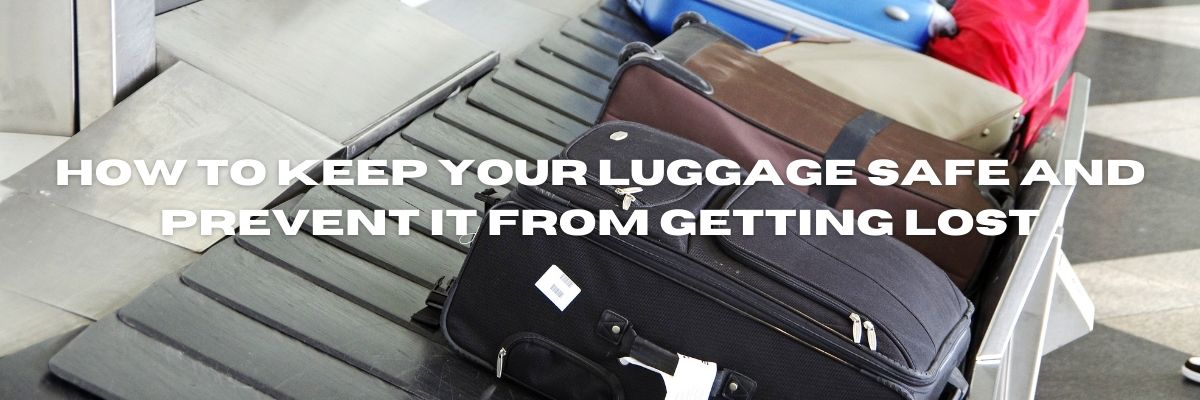How to Keep Your Luggage Safe and Prevent it From Getting Lost

There are few worse travel situations than arriving at your destination only to realize that your luggage didn’t make it, was delayed, or tampered with. It can lead to problems such as stress, financial losses, delays, and complex claim processes. Fortunately, there are some practical strategies to avoid luggage mishaps so you can start your trip the right way.
Pre-Trip Preparations
Label Your Luggage
Securely fitting a luggage tag is one of the simplest and most effective ways to safeguard your luggage. For maximum efficacy, ensure the tag is durable, fitted properly, and clearly visible. Also, it’s a good idea to add a second tag inside the bag in case the outer tag comes off or is damaged.
The tag info should include:
• Personal information.
• Contact details.
• Flight number and destination.
Choose the Right Luggage
Choosing the right luggage is essential. A bag that is lockable and sturdy will help prevent breakage and unwanted parties from gaining access. Additionally, opting for luggage that has distinctive features will allow for easy identification although avoid expensive-looking bags as this may attract unwanted attention.
Use Smart Luggage
There’s a range of smart luggage options on the market that are fitted with built-in GPS trackers. Alternatively, you can purchase a tracker and place it in the bag so you will know exactly where your luggage is at all times. Using trackers is a proactive way to locate your lost bags.
At the Airport
Check-in and Security Tips
Arriving late for your flight is the perfect recipe for mistakes, arriving early will significantly reduce the likelihood of any mishaps. Furthermore, during check-in be sure to double-check that your bags are closed correctly and locks are securely fastened.
Avoid Overpacking
An overpacked bag is vulnerable to damage that may expose its internal contents, especially during the handling process. So, steer clear of overpacking to avoid causing damage to your bags, and ensure easy handling.
Keep Valuables and Essentials in Carry-On
Bags that are within arm’s reach are far safer than bags stored in the plane’s cargo hold. For that reason, it’s important to keep certain items in your carry-on. This will ensure that should something happen; the most vital items will be safe and sound.
Carry-on items should include:
• Travel documentation.
• Essential medications.
• Valuables and electronics.
• Currency.
During the Flight
Use Direct Flights When Possible
Simply, the more transfers, the more chances there are for something to go wrong as bags must be moved between planes. To mitigate risk, book direct flights whenever possible. If your flight does have connection and your luggage does not go to your final destination, make sure to use a luggage storage at the airport or nearby.
Stay Vigilant During Layovers
If a layover is unavoidable, confirm with the airline staff that your luggage has been safely transferred. This will provide peace of mind that your bags are on board. It will also let the airline staff know that you’re paying attention which will reduce the chances of your luggage being targeted.
Keep Baggage Claim Tickets Safe
Baggage claim tickets are vital for retrieving your bags. Without them, you may run into issues when it comes time to collect your luggage. So, always be sure that you keep them secure until you have picked up your bags at your arrival destination.
Upon Arrival
Proceed to Baggage Claim Promptly
A common way bags go missing is at the baggage claim carousel. Therefore, arriving there as quickly as possible will dramatically reduce the probability of theft or misplacement.
Double-Check Luggage Tags
Luggage tags and baggage claim tags are super-important. When picking up your bags, always double-check that the luggage tag matches your baggage claim tag to avoid mix-ups.
Report Missing Luggage Immediately
Airlines have established procedures for retrieving lost or delayed luggage. If this happens, immediately report to the airline’s lost luggage counter and follow the subsequent steps for prompt resolution.
Additional Tips and Considerations
Use Luggage Locks
Not all luggage locks are created equal. To minimize the risk of tampering, secure your bags with TSA-approved locks.
Photograph Your Luggage
Taking photographs of your luggage and its contents is a great way to ensure that should a problem arise, there’s no ambiguity. This will help with compensation claims via airlines or travel insurance.
Travel Insurance
Travel insurance provides another layer of protection in the event your luggage is lost or delayed. It will ensure you are reimbursed fairly. However, be sure to check that the insurance policy covers lost or delayed luggage.
Common Questions (FAQ)

What should I do if my luggage is lost?
Here are the steps to take if your luggage goes missing:
1. Go to the airline baggage office immediately.
2. File a report.
3. Get a reference/tracking number.
4. Follow up and monitor lost baggage.
5. If necessary, file a compensation claim.
Can I track my luggage if it gets lost?
Yes. Once reported, the airline will provide a tracking number so you can monitor its status. Additionally, if you have a GPS tracker in your luggage, you can track its location yourself.
What compensation can I expect for lost luggage?
Airlines and travel insurance companies have compensation policies for both delayed and lost luggage. However, there are limits on the claimable amount so be sure to check. For travel insurance, it’s essential to verify it covers lost luggage in your policy.
How can I prevent my luggage from being stolen?
Here are some tips to prevent stolen luggage:
• Remain vigilant at the baggage claim carousel.
• Use tracking devices.
• Take photos.
• Double-check locks.
• Understand airline policies.
Are there items I should never pack in checked luggage?
Yes. Here are the items you should always keep in your carry-on:
• Travel documentation.
• Essential medications.
• Valuables and electronics.
• Currency.
Conclusion
The keys to keeping your luggage safe are using sturdy and unique travel bags, high-quality locks, and staying vigilant. Also, planning ahead, using tracking devices, and keeping your valuable items in your carry-on is a smart idea to prevent loss. Doing so will help ensure a smooth and safe journey for your luggage.



